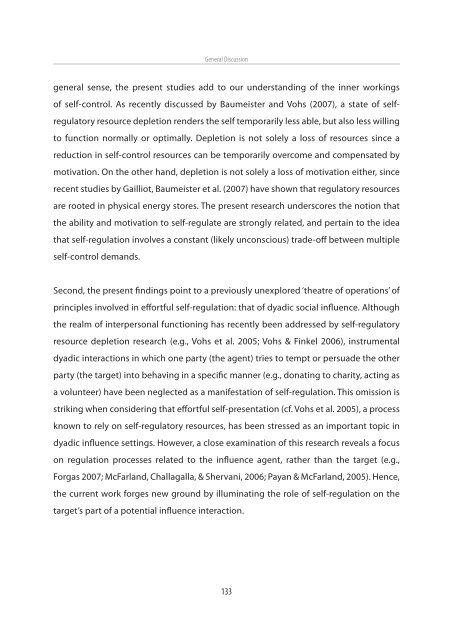Chapter 1 - Universiteit Twente
Chapter 1 - Universiteit Twente
Chapter 1 - Universiteit Twente
You also want an ePaper? Increase the reach of your titles
YUMPU automatically turns print PDFs into web optimized ePapers that Google loves.
General Discussion<br />
general sense, the present studies add to our understanding of the inner workings<br />
of self-control. As recently discussed by Baumeister and Vohs (2007), a state of selfregulatory<br />
resource depletion renders the self temporarily less able, but also less willing<br />
to function normally or optimally. Depletion is not solely a loss of resources since a<br />
reduction in self-control resources can be temporarily overcome and compensated by<br />
motivation. On the other hand, depletion is not solely a loss of motivation either, since<br />
recent studies by Gailliot, Baumeister et al. (2007) have shown that regulatory resources<br />
are rooted in physical energy stores. The present research underscores the notion that<br />
the ability and motivation to self-regulate are strongly related, and pertain to the idea<br />
that self-regulation involves a constant (likely unconscious) trade-off between multiple<br />
self-control demands.<br />
Second, the present findings point to a previously unexplored ‘theatre of operations’ of<br />
principles involved in effortful self-regulation: that of dyadic social influence. Although<br />
the realm of interpersonal functioning has recently been addressed by self-regulatory<br />
resource depletion research (e.g., Vohs et al. 2005; Vohs & Finkel 2006), instrumental<br />
dyadic interactions in which one party (the agent) tries to tempt or persuade the other<br />
party (the target) into behaving in a specific manner (e.g., donating to charity, acting as<br />
a volunteer) have been neglected as a manifestation of self-regulation. This omission is<br />
striking when considering that effortful self-presentation (cf. Vohs et al. 2005), a process<br />
known to rely on self-regulatory resources, has been stressed as an important topic in<br />
dyadic influence settings. However, a close examination of this research reveals a focus<br />
on regulation processes related to the influence agent, rather than the target (e.g.,<br />
Forgas 2007; McFarland, Challagalla, & Shervani, 2006; Payan & McFarland, 2005). Hence,<br />
the current work forges new ground by illuminating the role of self-regulation on the<br />
target’s part of a potential influence interaction.<br />
133
















